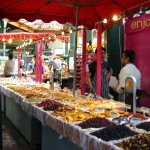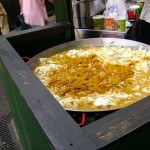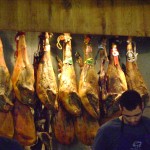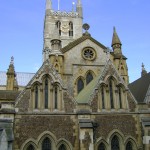Entries Tagged as 'Andrew B'
The BBC recently featured an interesting article discussing Internet matchmaking in the UK Sikh community. In the past, meeting people and dating over the web was shrouded in taboo and its legitimacy has always been in question. Throngs of success stories from major sites like eHarmony.com and Match.com have changed the public perception in recent years, however.
The UK is the home of the world’s second largest Sikh population (after India, of course). Many Sikhs are second-generation Indians torn between the completely different cultures of India and the West. Marriage is a particularly difficult and confusing subject. In India and elsewhere, most Sikh marriages are arranged by the parents. Occasionally, the bachelor or bachelorette will have some say in the matter. Such a practice is unheard of in Western culture. Here lies the essential difference: while Western marriages are based upon love, passion, compatibility, and chemistry between the two parties, modern Sikh matrimony is based upon pragmatism and stability. Sikh parents have marriage experience under their belts, possessing invaluable expertise about how to love your partner for life. Young people in Western society who fall helplessly in love one day are actually more likely to end up divorcing each other than remaining together. Alarmingly, divorce rates in many Western nations have breached the 50% mark. India has found its niche at the bottom of the list.
http://www.bbc.co.uk/religion/religions/sikhism/living/matchmaking.shtml shares the story of Jazz, a young Sikh man living in the UK who met his wife Nonie, who still lived in India, over the Internet. He and his friends were skeptical at first, but after Jazz and Nonie became happily married, the skeptics started logging on to sikhnet.com by the droves. While Internet courtship has only recently moved into the mainstream here in the UK, it has been socially acceptable for years over in India.
What I find most interesting about this particular union is that Nonie did not have any pictures uploaded. And Jazz didn’t care. From the BBC: “I didn’t see a picture of her. There was no chemical interaction. Instead got to know her character.” He believes that marriage is less about “chemistry and emotion” and emphasizes “the unification of two characters.” Sikh marriages seem to held together by a societal bond. Through happiness and hardship, the husband and wife remain resilient and adapt to each other. This holds in stark contrast to Western couples, who tend to split when the going gets tough.
The Internet dating option bypasses the the idea that Westerns cringe at, that the parents are in control. While her parents were out searching for a suitor, Nonie elected to set up a profile on Sikhnet that she could customize according to her individual character. Through email, the two got to know each other and felt a definite connection. The lack of physical contact removed the passion aspect that drives so many Westerners to unwise matrimony and subsequent divorce.
How many Americans who use dating websites would even bother contacting someone without a picture? Nonie writes, “For me being a Sikh is about continuing what my parents gave to me. It’s part of my identity. I wanted to marry someone who could share this with me so I didn’t lose my identity.” The institution of arranged marriage or emotionally detached courtship could only work for people whose religion is the most important aspect of life. Someone once asked me if I was a Jewish American or an American Jew. Fitting into the category of Western secularized, I consider my American identity to be more important than my Jewish heritage (much to the chagrin of most of my extended family and their oh so delicious matzo ball soup). This is purely speculation, but I would think that most of the Western world probably thinks along the same lines. I would never let my parents pick a woman for me. I plan on meeting a mate based upon what I wrote earlier: love, passion, compatibility, and chemistry. I can only hope I end up on the undivorced side of the fence.
Tags: Andrew B
Interspersing our travels from pub to pub for our walking tour, we decided to take a much needed Americana break. And what better place to go for a greasy, cheap Yankee fix than good old Mickey D’s. Before we even entered the restaurant, the not-so-subtle differences between McDonald’s in America versus Europe were apparent. One of the most distinguishing characteristics of an American McDonald’s is the ever prevalent red and yellow coloring, clinically proven to be associated with hunger and increased stimulation of the senses. Billions and billions served, right?
Another key aspect of any McDonald’s is their uncomfortable seating and their open dining areas. The seating in American McDonald’s are intentionally uncomfortable because they want you sit, eat, and get out as soon as possible in order to accommodate the next wave of kids with the munchies. The open areas perpetuate this with feelings of nakedness and over-exposure. In stark contrast, the McDonald’s here in London has a greenish brown color and a much different architectural design. Instead of one big open space, it was split into two relatively cramped floors furnished with cushy chairs on the lower level and long tables, comfortable stools, and a relaxed, cafe style sitting corner on the upper floor. This is most likely done in an attempt to fit in with the chic surroundings of the European cheap eating market. The menu above the counter featured “The M,” which is essentially a glorified quarter pounder with cheese, except much pricier and on a ciabatta roll. But it was advertised in such a pretty font! They also had free wi-fi, which is sweet.

From http://snackspot.org.uk. So succulent. So overpriced.
From http://snackspot.org.uk. So succulent. So overpriced.
This brings up an important difference between American and European eating habits. Fast food back in the States is called fast for a reason. Customers generally don’t spend hours on end sitting in a Burger King. Drive-thrus come standard with every establishment. I have seen literally one drive-thru since I’ve been here. It seems that the European equivalent of the American fast food burger joint is the cafe. Pret a Manger and Eat cafes, not McDonald’s and Wendy’s (although there are a surprisingly large quantity of KFCs) dominate the cityscape. Cafes go hand-in-hand with the laid back attitude so prevalent in this continent.
This is a photograph of a London McDonalds. The one following is American.

http://coolboom.net/en/wp-content/uploads/2007/09/mcdonalds-london2.jpg

http://www.norh.com/news/0904/news-0904/insidemcdonalds.jpg
There is no way an American style McDonald’s could survive in London. The McDonald’s at St. Paul’s was sandwiched between two cafes. The decor and atmosphere of the restaurant effectively fit in with its distinctively European neighbors. The stereotypical American McD’s – bright, noisy, grungy, and crowded – would wither and die in the face of the far superior and definitely healthier European chain cafes. And although the fatty, disgusting-but-oh-so-good food is exactly the same, the atmosphere makes us feel healthier, and thus happier. Perhaps if the fast food places of the United States were more like the ones here they would not have such a negative reputation. Or maybe more cafes like Pret ought to pop up on our streets back home. Who knows?
Tags: Andrew B · Andrew F · Andrew R · Campbell
September 2nd, 2009 · 1 Comment
Author’s Note: This post was written and live by yesterday at 2:45 PM. Due to systems maintenance back at Dickinson where the servers are, it was mysteriously deleted and all traces ceased to exist on the Internet. Fortunately I managed to find a partial backup of the post with Firefox’s super clutch about:cache utility. Panic attack over.
Okay, so I was the only one who opted out of going to the backstage tour of the National Theatre. Bad call Andrew, bad call. So while I depressively sit in my room waiting for the group to return, I might as well write one big über-post reflecting on the last week or so here in Britain.
To go back a few days, after Stonehenge, we schlepped out to Bath. I experienced some major mixed fellings on the way there. A knowledgeable friend told me that if there is one place to see in the UK, it is Bath. However, it’s a city whose economy is completely reliant on tourism, and I hate tourist traps. The city itself is a sight to be seen. The architecture stands out most clearly, as almost every building within the city limits is built in the Georgian style of the 18th and 19th Centuries.

http://en.wikipedia.org/wiki/Bath,_Somerset
The first landmark we encountered was Bath Abbey, a picturesque Gothic cathedral from the 7th Century. I stood outside and stared at the exterior for a good ten minutes before entering. It is enchanting, imposing, captivating, and just about any other adjective of the sore fathomable. With that in mind, I was thrilled to go inside. The interior was the mixed feelings I had earlier incarnate. The nave itself is gorgeous, featuring high, vaulted ceilings and intricate stained glass windows reminiscent of Westminster. Juxtaposing the ancient architecture, however, were LCD monitors, postcard stands, and any other touristy accoutrement you can imagine. That made me physically sick to the stomach. It is one thing to have a gift shop attached to historical sites, as long as they are distinctly separated. There is nothing wrong with a tourism economy. But just as the Church and the State should be mutually exclusive, so should the site and the shop. A message to the tourism bureau of Bath: NEVER SHIT WHERE YOU EAT. It is not only offensive to the historical purity of the building, but downright sacrilegious to so blatantly mix shopping with as place as important as Bath abbey.
On a related note, The Tower of London wasn’t any better. Maybe we just chose the worst possible time to visit, but it was absolutely stuffed to the gills with sightseers. We forewent seeing the illustrious crown jewels because the queue was longer than the line for Splash Mountain in Disney World. And I’m sure the main attraction isn’t nearly as exciting. To be entirely honest, I didn’t learn much during my time at the Tower. I know that it is very rich historically, serving as a fortress, a prison, a headquarters, and most recently, a kitschy tourist trap. The most best aspect were the enormous ravens hanging out all over the grounds. They made entertaining noises. Not worth the money. (I took the following photographs.)


CAWWW!
Phew. Ranting is cathartic.
Also, I am attempting to embed a slideshow of Bath Abbey into this post, but am failing miserably. I am giving up and posting a link to a slide.com slideshow instead. Click here to view.
Moving on, yesterday was the world famous Notting Hill Carnival, the second largest street festival on the planet. To give the reader a perspective, imagine a crowded rock concert, complete with all the four essential, ubiquitous smells: food, beer, body odor, and ganja. Now take that crowd and spread it out over a twenty square mile radius, but don’t bother thinning out the population density. This year’s attendance figures aren’t live yet, but in past years the event has attracted an upwards of 1.5 million people split over two days, most on Monday, the main event. Since everything else is closed due to the national bank holiday, about an eighth of London’s population has nothing better to do, so why not get a taste of Afro-Caribbean culture and go to Carnival? (When reading, make sure to roll the R in Carnival for dramatic effect). Everywhere I went was in earshot of calypso, reggae, soca, or any other Caribbean-centric music played at rock concert decibel levels. There were more jerk chicken booths than Starbucks in Manhattan. Red Stripe and Corona quenched the throats of everyone, from the lavishly dressed parade people to the pasty white 20-somethings who can’t dance, in attendance just to escape the vanilla routine of Western life (i.e. me). It is definitely worth seeing, but make sure you arrive in the afternoon. We made the mistake of getting there at 10 AM, and were bored for about two hours.
Slideshow attempt #2
On a completely unrelated note, I have been listening to a lot of jazz lately, namely good hard-bop from the early 70s. I listen to a lot of music and it is by far one of my favorite genres, especially when seen live. As a result, I’ve been craving some raw, live jazz, and what better place to experience it than in the cultural center of the UK. I’ve also been considering writing my research paper on the London jazz scene, so it’s probably a good idea to get out there and experience it first hand. My rabid Googling has pointed me to a place called the 606 Club (click the link to see where the club got it’s name). The reviews are pretty glamorous (“London’s best music venue”), so I’m very excited to go in for a cocktail and listen to some great improvisational jazz, or whatever they have playing that evening. If you have never seen good jazz played in person, trust me on this one and come along to see the show. It is truly the best kind of live music around. Skilled musicians can emanate such powerful emotion from their horns, basses, drums, or voices unheard of in rock, hip-hop, or anything else kids today listen to. Definitely worth the £10 or so cover.
That about does it for now. I’m gonna get back to drinking wine alone in my underwear.
Tags: Andrew B
Get it? It’s a play on words. Like because Stonehenge is awesome and made of rock. I’ll be here all week, folks.
On a less cheesy note, Stonehenge really was a great experience. I had done some research prior to visiting, so I was already well aware that no one really knows anything definite about the place. The fantastic audio tour confirmed that. All we know is that the oldest rocks are about 5000 years old and that separate sections were built in phases spanning thousands of years. Otherwise, no one actually knows what purpose Stonehenge served. Speculations run the gamut from astronomy to human sacrifice to showing off how many giant π‘s one could build out of gigantic rocks. Maybe not the last one so much, but then again, who knows?

πππππππ
The first phase of building dates back five millenia as an earthwork called a “henge.” No rocks were in place yet, just big ditches dug with primitive tools most likely made from bones and antlers. A few thousand years later in about 2000 BC, the first group of stones, known as “bluestones,” were placed in a configuration now known as the inner circle. Seeing how each of the rocks weigh an upwards of 4 tons and are from a mountain 250 miles away, transportation must have been a pain.

Bluestones in the middle
The outer stones, known as “sarsens” weigh something like 50 tons. How on earth could humans move rocks of that magnitude 3000 years ago? It absolutely blows my mind that what humans can accomplish, regardless of how primitive technology might have been. It is estimated that an upwards of 600 men were used to transport each rock. The sarsens were placed in holes in a parallel formation to accommodate large stone lintels placed on top.

Post and lintel formation
Other than that, Stonehenge is a complete mystery. My favorite theory comes from the time of King Arthur. Legend has it that the a treasonous Saxon leader massacred 300 British noblemen. The great wizard Merlin decided that Stonehenge would be a great burial ground, so he called for the huge stones to be transported to the site from Ireland. The Britons weren’t strong enough to move them, he used the magic arts to help them out. But how did the rocks get to Ireland in the first place? Giants brought them from Africa of course!
The few short hours we spent at Stonehenge were enlightening. It was a perfect follow up to my epiphany at Westminster about the boundless capability of human minds and hands harnessing the power of reason (Merlin story notwithstanding).
Tags: Andrew B
My previous post on Westminster focused on the modern martyrs represented by statue on the church’s exterior as well as the riveting tomb of the Unknown Warrior. Something else has been reverberating in my head since I’ve left – humanism in the church. Humanism is a philosophy based upon the inherent human ability to reason and lead autonomous, dignified lives. Throughout history, The Church has prolifically opposed humanism. Faith, the most important and base-level aspect of Christianity, is inherently unreasonable. A basic precept of humanism is that all humans have dignity, the capability to accomplish anything they choose to set their minds to do, only limited by their own intelligence, ability, and motivation. Complete devotion and humility to God by means of faith limits dignity.
Here comes the ironic part. Juxtaposing the religious symbols and artifacts displayed in ubiquity was a whole slew of scientists, mathematicians, musicians, poets, writers, and a slew of other men and women of notability. The funny part was, none of them were known for their religious achievements. In fact, Charles Darwin himself, the guy whose teachings the Christian Right battles every day, is buried in the church. Right next to an altar where services are held.
I don’t know if ironic is the right word, actually. Sir Isaac Newton, the father of modern physics who happens to be enshrined on the altar exactly where a crucifix would be in any other church, was a deeply religious man. After publishing his works on gravity, he was asked how he could concurrently believe in gravity and in God. He told the inquirer that there is no doubt in his mind that the world is governed by gravity and his other findings. God simply set it all in motion. Legend has it that Darwin personally rescinded all of his discoveries with the hopes that he would end up in heaven.
Darwin, Newton, et. al. are champions of humanism. They accomplished everything by their own means. Despite their religious views, it was their dignity and appreciation of reason that allowed them to dramatically change the world in ways previously unseen. The decision to so proudly display such heroes of science and humanity gives me hope for the future of Christianity.
Tags: Andrew B
I won’t beat around the bush, Westminster Abbey is gorgeous. Stunning. Spectacular. The fact that it was built by mere human hands and some scaffolding is astounding. While the architecture and decor are breathtaking, it is the symbolism represented on the walls outside the church as well as the shrines within that truly captivated me throughout my visit.
Amongst the first aspects of the cathedral discussed by our cheerful, humorous, and incredibly informative tour guide, John, was the sculptures adorning the front exterior wall. There are statues standing imposingly on the ledge above and around the entrance. The sculptures are martyrs of contemporary times, both Christian and secular. The Christian figures represent those who died in the name of their faith from places such as Nazi Germany and Apartheid-era South Africa.
What really stunned me were the representations of what I’ve always believed the church would find oxymoronic: secular martyrs. Saint Elizabeth of Russia was killed by the Bolsheviks for helping the poor. German theologian Dietrich Bonhoeffer was murdered by the Nazis in a concentration camp for his prolific works of poetry and music. Most famously, Dr. Martin Luther King was the voice of the American civil rights movement in the 60s. He was assassinated as well. These people are not known for their contributions to the church or for their faith in Jesus. They were faithful to their noble causes, and they died for them. For Westminster to honor these heroes by placing their visages on the entryway to one of the most famous and important churches in the world is marvelous.

Luwum, Elizabeth, King, Romero, Bonhoeffer
Once we got inside, the cavernous space was overwhelming. Unfortunately, photography was strictly verboten, so I will post whatever pictures of the interior the Internet has to offer.

After the initial shock from being in the structure wore off, I listened carefully to what John had to say. The tomb of the Unknown Warrior really stirred me. After World War I, parliament was considering placing a memorial dedicated to the memory of British lives lost during the war inside the abbey. There was major debate as to how to accomplish this, however. In 1920, Rev. David Railton, chaplain on the western front suggested that a few bodies be disinterred from battlefront graves and placed in a tomb dedicated to the “unknown warrior,” the common British soldier not commemorated for his service to the Queen. After much debate, this idea was decided on and action began. Four to six bodies were exhumed and brought to France where they were covered with a Union Jack. Brigadier General LJ Wyatt was blindfolded and picked one soldier. The body was placed in a coffin and transferred back to England where it was buried in Westminster and covered with a commemorative slate. The other bodies were placed back in their original resting places. The tomb is an emotional reminder of the value of life, regardless of social class or heroism. Every life is sacred. War destroys lives and throws families into despair. Overall, my experience in Westminster was extremely powerful, especially because of this memorial.

Of all the hundreds of graves in Westminster, this is the only one not allowed to be stepped upon
Tags: Andrew B
Google is leading me astray. I have only been in London for five days, but I have seen more pubs than I could ever fathom existed in such a small area. I mean, London isn’t small by any stretch of the imagination, but come on. There is a pub on every corner! Pubs are across the street from pubs. This is like Starbucks in New York City, except a lot better.
I remember the first day in this city I asked Professor Qualls what the ratio of pubs to people is, and his response was, simply, “very high.” Since I am a child of the internet age, naturally I asked good ole Google how many pubs exist in London. The answers I have found range from the laughably inaccurate 38 to the ludicrously enormous 7000. So I remain in doubt as to how many public drinking establishments really exist here.
Then again, what exactly defines a pub? Is a café that serves beer and/or liquor requisite? Or does it have to have wood paneling, at least six kinds of ale on tap, a loyal set of customers, and a coat of arms out front? According to Encyclopedia Britannica, a “public house” is an establishment that serves alcohol to be consumed on site (or out front, if the weather is nice). So technically, the ever-prestigious Museum of London is a pub. So is the Docklands. Heck, the furniture store on Tottenham probably sells booze.
So what’s the point of all this? Compare this abundance of pubs to America. It is rare to find bar after bar after bar across from a bar caddy corner to a bar in any place I’ve ever been, big cities included. Having done minimal research, it is safe to say that the reason can be summed up in one word: culture. It is extremely common to frequently spend long evenings with friends over a pint or two or seven in the local _______ Arms down the street from your flat. Social class has nothing to do with it. Granted, many people tend to stick to their own kind when going out (again, I’ve only been here five days, so feel free to shoot me down), but such a huge sampling of the city frequents pubs. It is safe to say this based on the grounds that there are just so many places to go. How else could they stay in business? I have no idea how competition plays into things, but any economics majors in search of an interesting thesis topic, look no further than British pubs.
The relatively nice bar I bartended at a few years back attracted people in a lower economic echelon. Despite the bar’s high prices, the main clientele was comprised of truck drivers, granite workers, and other blue collar folk. It is egregious to say that poor people go to bars more than the rich, but compared to London, this is the way it seems to be. I am certain that the class blindness of pub culture will become even more apparent the more time I spend out drinking with locals and learning the ins and outs of London culture.

Interior of a typical British pub from http://static.laterooms.com/hotelphotos/laterooms/89745/gallery/masons-arms-york_030320091553041117.jpg
Tags: Andrew B · Pubs
Tags: Andrew B
Our day began at nine when we left the Arran House and took the tube down to Borough Market. Arriving there early is key because it became quite crowded in the ensuing hours. The market itself is a diverse collection of vendors selling every kind of food imaginable. Ever had a prawn sandwich? How about some rose flavored Turkish delight? Anthony wasn’t so keen on the former, but you get the idea.
Although the market included common grocery items such as fruit, vegetables, and bread, we also saw more unique items on display such as venison, ostrich meat, lassi, and a hanging puffer fish. All suburban Americans have had full meals comprised of free samples. After today, Costco will never be the same. We tasted a wide array of ethnic candies, chutneys, spreads, and much more. Our senses were tickled by the delicious smell of fresh curry, strange meat being butchered, and gorgeous, albeit expensive flowers on display.
After having our fill of distinctly non-American food, we proceeded to the adjacent Southwark Cathedral, the oldest gothic church in London. We all agreed that it is the most beautiful building we have ever set foot in. A place of worship for 1400 years (that’s right, this place is over a millennium old), it was filled with intricate stained glass windows, ornate carvings, and imposing statues. Most interestingly, the tombs of many of the church’s benefactors are located both beneath the floor and on display inside the cathedral itself. Perhaps the most haunting of these was the frighteningly realistic “emaciated corpse” carved from stone in the 14th Century. Some of the church’s most famous frequenters included Dickens, Chaucer, and Shakespeare, who is immortalized in statue.
Next, we stumbled upon a life-sized replica of Sir Francis Drake’s galleon, the Golden Hinde, one of the first of its kind to circumvent the globe. Having travelled over 140,000 miles, we were blown away by its sheer size and intricacy. Also, what the hell was a ship doing in the middle of the street? Whatever.
The highlight of our day was the Menier art gallery. Managed by an old British couple, the building was unassuming and tucked away, separated from the hustle and bustle of the marketplace. The gallery housed a small but diverse mix of works spanning a myriad of artistic schools and styles. We enjoyed chatting with the charming proprietors, who graciously told us about their upbringings in northern England. This was masterfully illustrated by paintings by one of the owners. One was of a line of houses overlooking a serene beach and rocky white cliffs. Incredibly, this same placid beach was heavily fortified with barbed wire during WWII to prevent a German invasion. Hitler decided to try to pull a Napoleon and attempt to conquer Russia instead. We all know how that turned out. The couple still visits their childhood town today.
Overall, our time in the Borough was an exceedingly positive experience. If you are looking for widely mixed collection of cultures selling their foods and wares, this is the place for you. We fancy returning in the future. However, a word of advice: try to avoid Bank tube station any time after 10 AM. The extreme congestion made our journey home more difficult, as the wonderful aroma of body odour (note the spelling) invaded our nostrils.
Tags: Amy · Andrew B · Anthony
So for our first independent day in London, Maddie and Andrew tubed (that’s a word now) to the oh so amazing Camden Town. Before we left, our only perception of Camden was from New Jersey, which is a shithole. Needless to say, we were both more than pleasantly surprised. Three stops down from Goodge St. we disembarked the train and feasted our eyes on the eclectic streets of Camden Town. To quote a friend of Andrew’s, it is “The Venice Beach of London.” He wasn’t kidding. It is a counter-cultural Mecca abundant with youthful vibes and great music. The town seemed to be divided into sections by musical genre. We initially entered into a world of punk rock, black leather corsets, and tattoo parlors. We traveled through a world of hippies, metalheads, new agers, and everything in between. It was a maze of marketplaces, reminiscent of the Middle Eastern shouk where merchants peddle their wares, expecting haggling.
Neither of us think we saw a single person over forty. It is a major hangout for youth, especially those musically oriented. Amongst the record shops and live music cafes, we encountered a diverse mix of people, sounds, and smells ranging from France to Bangladesh to Thailand and back. People from all walks of life are not only welcome, but encouraged to spend time in Camden Town. The people we spoke to were very friendly and eager to discuss their unique perspective as either a resident or frequenter of the area. Both of us agreed that our time in Camden will be never forgotten. Our mutual love of music and interesting people will guarantee that. We highly recommend that EVERYONE IN THE WORLD visits Camden Town.

Visit Camden or this guy will pierce you in your sleep!
Tags: Andrew B · Maddie





















